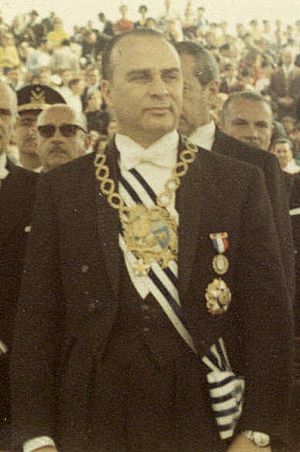Jorge Pacheco Areco facts for kids
Quick facts for kids
Jorge Pacheco
|
|
|---|---|

Pacheco in 1968
|
|
| President of Uruguay | |
| In office December 6, 1967 – March 1, 1972 |
|
| Vice President | Alberto Abdala |
| Preceded by | Óscar Gestido |
| Succeeded by | Juan María Bordaberry |
| Vice President of Uruguay | |
| In office March 1, 1967 – December 6, 1967 |
|
| President | Óscar Gestido |
| Preceded by | Alfeo Brum |
| Succeeded by | Alberto Abdala |
| Personal details | |
| Born |
Jorge Pacheco Areco
April 9, 1920 Montevideo |
| Died | July 29, 1998 (aged 78) Montevideo |
| Political party | Colorado Party |
| Spouses |
|
| Children |
|
| Occupation | |
Jorge Pacheco Areco (born April 9, 1920 – died July 29, 1998) was an important Uruguayan politician. He was a member of the Colorado Party. He served as President of Uruguay from December 1967 to March 1972.
Contents
Starting in Politics
Pacheco joined the Colorado Party in the late 1950s. In 1962, he was elected to the Chamber of Deputies. This is like being a representative in a country's parliament.
In 1967, he became Vice President of Uruguay under President Óscar Gestido. This role had not been used for several years before he took office. Pacheco was the sixth person to hold this position in Uruguay.
Leading Uruguay as President
Jorge Pacheco became president in December 1967. This happened after the elected president, Óscar Gestido, passed away just a few months into his term.
Tackling Economic Challenges
As president, Pacheco quickly put in place price and wage freezes. This means he tried to stop prices and salaries from going up. He did this to control inflation, which is when money loses its value and things become more expensive.
To handle the problems this caused, like labour disputes (workers disagreeing with their employers), he declared a state of emergency in June 1968. This gave the government special powers to keep order.
Dealing with the Tupamaros
His government also faced a group called the National Liberation Movement (MLN). They were also known as the Tupamaros. This was an urban guerrilla group that had formed in 1963.
With approval from the country's Parliament, the government used emergency measures. These measures lasted from June 1968 to March 1969.
Trying for Re-election
Uruguay's constitution does not allow a president to be re-elected right away. Because of this, a special vote was held in 1971. This referendum was to change the constitution so Pacheco could run for a second term. However, the change was not approved by the voters.
After His Presidency
After leaving office, Pacheco continued to serve his country. He became an ambassador to different countries. An ambassador is a diplomat who represents their country in another nation. He served as ambassador to Spain, Switzerland, and the United States.
He returned to Uruguay in 1982. This was to take part in the first steps towards bringing back democracy after a period of military rule. He ran for president again in 1984 and 1989, but he did not win.
Pacheco supported the new Colorado Party governments. He even served as ambassador to Paraguay. In 1994, despite his health, he ran for president one last time. Although he didn't win, his votes helped the Colorado Party win the overall election.
After the 1994 elections, Pacheco retired from politics. He passed away on July 29, 1998. He was buried with special honors at the Central Cemetery of Montevideo.
His Family's Political Roots
Jorge Pacheco came from a family with strong connections to politics.
His father, Manuel Pacheco, was a doctor and a politician. His grandfather, Ricardo Areco, was also an important politician in the early 1900s.
His son, Jorge Pacheco Klein, also became a politician and served as a deputy for the Colorado Party.
See Also
 In Spanish: Jorge Pacheco Areco para niños
In Spanish: Jorge Pacheco Areco para niños
- Politics of Uruguay
- Colorado Party (Uruguay)
- List_of_political_families#Uruguay
- Tupamaro National Liberation Movement

